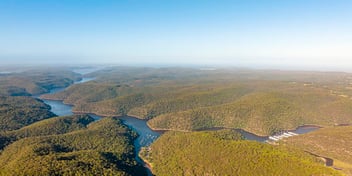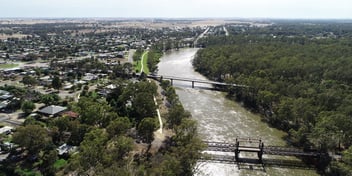Better river management relies on understanding their geomorphology
Through a joint partnership, the New South Wales (NSW) Government and Macquarie University are advancing sustainable river management, creating a comprehensive database of rivers across the state.
Rivers are diverse. They are diverse in their physical character (morphology and form) and they are diverse in their behaviour (dynamic processes). This diversity makes them unique and worth valuing, providing ecological habitats, energy dissipation and access to human water use.
To manage for river diversity, we need a consistent approach to understanding and describing what makes our rivers different and valuable. To do this, we use geomorphology – the study of earth surface forms and processes – applied with other river knowledge. Geomorphology can help to explain why rivers are different from one another, in terms of their structure, their function and their capacity to adjust in different ways.
 (Image: Fergus Hancock)
(Image: Fergus Hancock)
Applying the River Styles Framework
Over the last 20 years, the NSW Department of Planning, Industry and Environment - Water has been working with Macquarie University to develop the NSW River Styles database. The database uses the River Styles Framework* for the geomorphic analysis of rivers. It contains a coherent and consistent dataset on a river’s:
- character and behaviour (structure and function)
- geomorphic condition (integrity), and
- potential for recovery (improve in condition).
This information provides a solid basis for prioritisation and decision-making in river management. It helps us to interpret river types, assess their geomorphic condition and determine whether a river is likely to improve its condition and recover (or not).
The Framework also helps us identify rare and threatened river forms across NSW that may need protection. Grouping rivers based on their similarities, and understanding differences, is critical for management. Appropriate protection or rehabilitation activities can be designed and targeted that work with the river type, its condition and recovery potential, as part of process-based, recovery enhancement and nature-based approaches to river management.
 The Karuah River. (Image: Fergus Hancock)
The Karuah River. (Image: Fergus Hancock)
The NSW River Styles Database
More than 219,000 km of river reaches across NSW have been assessed using the River Styles Framework. The NSW River Styles database captures this assessment. The database is the largest and most comprehensive dataset of geomorphic river character, behaviour, condition and recovery available in Australia.
The database and Framework can be used to develop sustainable ways of managing rivers for ecosystems and other water users. Users can now consistently compare the geomorphic attributes of rivers across NSW.
The department will use the database and Framework to support and improve river management in several ways. These include:
- knowing what kind of river you’re working with and identifying river values;
- recognising and treating underlying causes of issues, rather than just the symptoms;
- developing and using monitoring, evaluation and reporting protocols that measure physical condition for the river type in a consistent way;
- integrating and aligning environmental decision-making across agencies and disciplines by using a consistent and verified framework;
- understanding the relationships between the physical structure of river systems, habitats and ecological populations; and
- prioritising management actions to be more strategic and efficient with use of water resources.
These changes will help to manage rivers in NSW more effectively. You can view the NSW River Styles Database on the department’s website.
*Macquarie University is the developer of the River Styles Framework.


